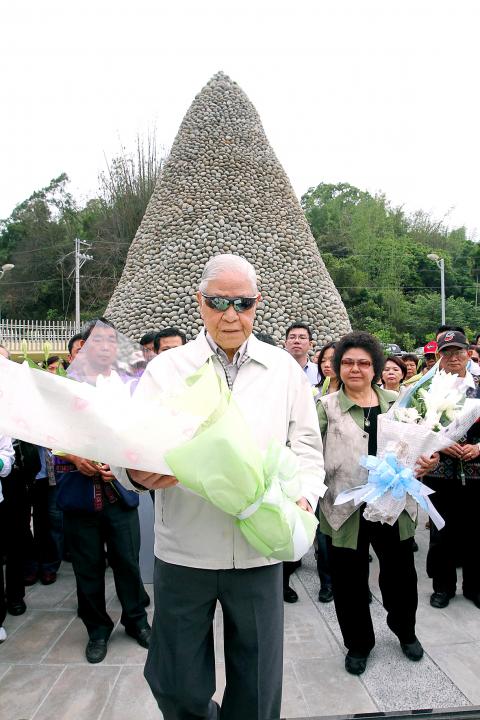Former president Lee Teng-hui (李登輝) yesterday mourned those who perished in the village of Siaolin (小林), Greater Kaohsiung, in 2009 and reiterated the government’s responsibility to care for people’s well-being as he concluded his three-day visit to southern Taiwan.
Lee, in a ceremony held at Siaolin Memorial Park yesterday morning, mourned the 462 people killed at Siaolin, which was wiped out in a landslide when Typhoon Morakot devastated the south of the nation in August 2009.
The 89-year-old said it has always been his wish to pay tribute to the dead in Siaolin and he always has a “heartbroken” feeling whenever he thinks about the tragedy, but he had to wait until he had recovered from surgery for cancer to visit the park.

Photo: Chang Chung-yi, Taipei Times
Accompanied by Kaohsiung Mayor Chen Chu (陳菊) and a group of residents, Lee toured the park and presented bouquets in front of a pyramid-shaped stone memorial.
He praised the rebuilding efforts of the Greater Kaohsiung Government, saying it was able to take care of the survivors by relocating the village and a permanent housing project, as well as commemorating the deceased, including the installation of 462 name plaques for the dead and the planting of 181 trees at the park to symbolize the 181 families that lived in the village.
“Rarely have we seen governments around the world that have been able to rebuild with such efficiency,” he said. “This is what a democratic society is all about. Governments implement every policy with people’s well-being and their benefit in mind.”
That is why he was promoting local autonomy and local governments, as opposed to the centralization of power, during his three-day trip to Pingtung County and Greater Kaohsiung, he said.
The former president on Wednesday and Thursday urged local governments to fight for their power, rights and land, because the central government neither understands the public’s hardships and difficulties, nor listens to public opinion.
Speaking at a plaza in the memorial park against the backdrop of the devastating landslide, Lee said the park “means a lot to me personally.”
Lee said he had visited the area twice now and both visits had symbolic implications.
In 1986, when he served as vice president under then-president Chiang Ching-kuo (蔣經國), Lee, a devout Christian, was given an order to resolve the “Mount Zion controversy,” Lee recalled.
Mount Zion is a 200 hectare mountainous area bought and developed by a New Testament Church in the 1960s.
The church promoted self-government and had a long history of fighting against the Chinese Nationalist Party (KMT) regime, which deployed police and troops to expel worshipers from the area by force, raising human rights concerns.
The visit was the first of a series of trips Lee is scheduled to embark upon, with trips to other parts of the nation being planned.

Trips for more than 100,000 international and domestic air travelers could be disrupted as China launches a military exercise around Taiwan today, Taiwan’s Civil Aviation Administration (CAA) said yesterday. The exercise could affect nearly 900 flights scheduled to enter the Taipei Flight Information Region (FIR) during the exercise window, it added. A notice issued by the Chinese Civil Aviation Administration showed there would be seven temporary zones around the Taiwan Strait which would be used for live-fire exercises, lasting from 8am to 6pm today. All aircraft are prohibited from entering during exercise, it says. Taipei FIR has 14 international air routes and

Taiwan lacks effective and cost-efficient armaments to intercept rockets, making the planned “T-Dome” interception system necessary, two experts said on Tuesday. The concerns were raised after China’s military fired two waves of rockets during live-fire drills around Taiwan on Tuesday, part of two-day exercises code-named “Justice Mission 2025.” The first wave involved 17 rockets launched at 9am from Pingtan in China’s Fujian Province, according to Lieutenant General Hsieh Jih-sheng (謝日升) of the Office of the Deputy Chief of the General Staff for Intelligence at the Ministry of National Defense. Those rockets landed 70 nautical miles (129.6km) northeast of Keelung without flying over Taiwan,

City buses in Taipei and New Taipei City, as well as the Taipei MRT, would on Saturday begin accepting QR code payments from five electronic payment providers, the Taipei Department of Transportation said yesterday. The new option would allow passengers to use the “transportation QR code” feature from EasyWallet, iPass Money, iCash Pay, Jkopay or PXPay Plus. Passengers should open their preferred electronic payment app, select the “transportation code” — not the regular payment code — unlock it, and scan the code at ticket readers or gates, General Planning Division Director-General Liu Kuo-chu (劉國著) said. People should move through the

The Ministry of National Defense (MND) today released images of the military tracking China’s People's Liberation Army (PLA) movements during the latest round of Chinese drills around Taiwan. The PLA began "Justice Mission 2025" drills today, carrying out live-fire drills, simulated strikes on land and maritime targets, and exercises to blockade the nation's main ports. The exercises are to continue tomorrow, with the PLA announcing sea and air space restrictions for five zones around Taiwan for 10 hours starting from 8:30am. The ministry today released images showing a Chinese J-16 fighter jet tracked by a F-16V Block 20 jet and the